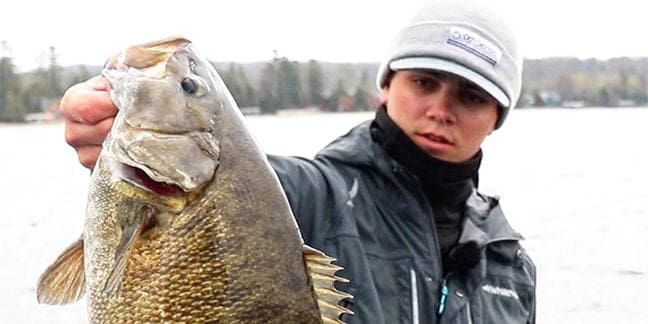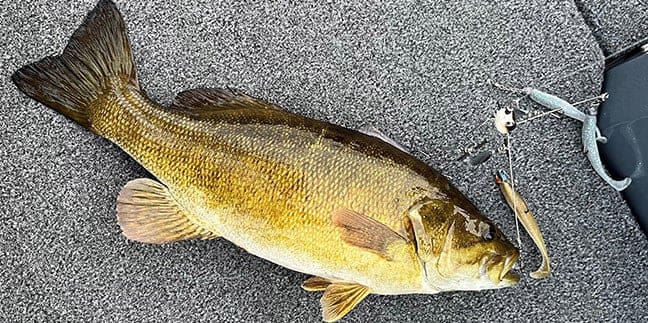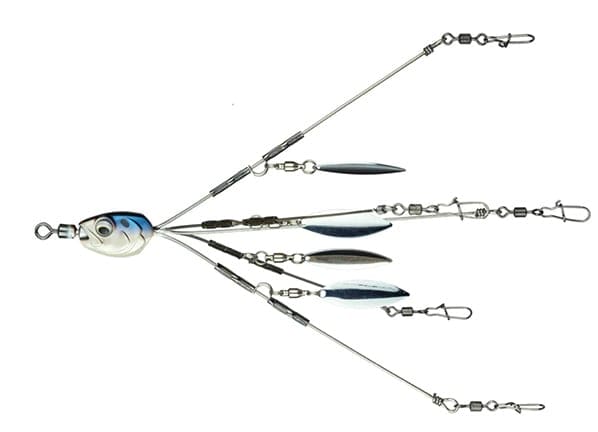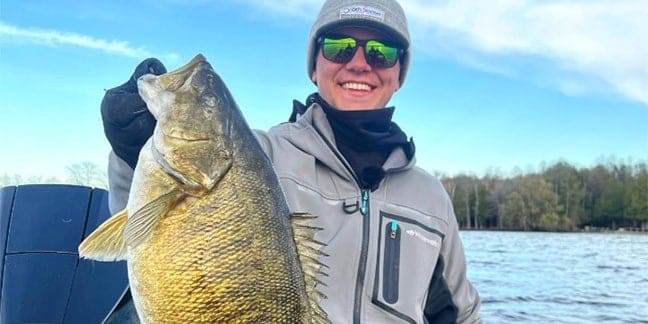“Fall is my favorite time of year to throw A-rigs for big smallmouths,” says hardcore Michigan-based bass angler, Kyle Kunst.
“The availability of bait is the most important thing when throwing an Alabama Rig in the fall. Bait schools congregate and the smallies go on feeding binges, packing on calories for winter in the shortest amount of time possible.”
Given this phenomenon, Kunst says the Alabama Rig makes a great fall smallmouth bass presentation, a pleasant power-fishing departure from the lighter gear and finesse rigs used to tap finicky bites throughout much of the summer.
Weather Conditions & Target Depths
In terms of weather, Kunst says he catches more late-season brown bass when there’s “wind and waves” and it’s completely overcast—or the sun is just peeking through the clouds.
“I’ve never caught loads of fish on bright, sunny days. My best days are always partly cloudy, windy, or straight overcast and windy. The wind is a critical factor to push the bait around and break up water visibility. A lot of the Michigan lakes I fish are very clear, so chop helps break up the surface and disguise the Alabama Rig since it’s a large, bulky presentation with wires and heavier line. However, when fishing stained waters, I do tend to catch more fish when the sun’s out,” notes Kunst.
Kunst targets a wide range of water depths with the Alabama Rig, zones from two feet to 30 feet.
“A lot of it depends on water clarity. If the water is more stained, I will target shallow cover. If it’s super clear, smallmouths will typically relate to deeper areas,” says Kunst.

He says fishing an Alabama Rig deep isn’t as painstaking as you might think. His order of business is making long casts, letting the rig hit the water surface, and then counting it down 10 to 15 seconds.”
Additionally, notes Kunst, forward-facing sonar like LiveScope, MEGA Live, and Active Target has completely changed the A-Rig game.
“With LiveScope, I can watch my bait fall through the water column in real-time and then monitor it all the way back to the boat. So, you know exactly where your bait’s at in the water column at all times. That’s why I’ve been able to fish an A-Rig out to 25- to 30 feet of water. With LiveScope, I can ensure my rig stays in the strike zone.”
When targeting cover vs. open water bait balls, Kunst is a big fan of searching out submerged trees and rock piles that smallmouth bass can sit next to or under, emerging quickly to ambush prey, like a precisely positioned Alabama Rig.
In the Michigan lakes that Kunst fishes, predominant forage comprises balls of various year class perch and shiners, but the farther you travel south, you’ll encounter massive schools of gizzard and threadfin shad.
The Right, Recommended A-Rig Gear
Kunst fishes a 7’11” heavy power, moderate action baitcasting rod for “pretty good casting distance” as well as rod handle ergonomics that allow him to maintain leverage when casting out a large, heavy umbrella bait.
“Another critical thing is using a larger baitcaster,” says Kunst. “I like a size 200 or 300 reel so I can really fill up the larger spool with large diameter 20-pound fluorocarbon, pretty much a staple with the technique.”
He adds that a moderate action rod really gives him the ability to “load up” on fish and keep fish pinned once hooked.

A-Rig Specifics
Talk to a dozen different A-Rig anglers and you’ll get a dozen different ways of how to tweak an Alabama rig.
For Kunst, he likes to use two lighter swimbait jig heads on the upper two arms of the umbrella, typically 1/16- or 1/8-ounce jig-heads, outfitting the other three of five arms with heavier heads, typically ¼-ounce, but sometimes heavier (as in 3/8- or 5/16-ounce) depending on the depth fished.
Color-wise, Kunst keeps four baits the same color and then chooses a standalone color for the very back, middle arm and swim-style jig-head.
“I like to make the back, middle bait an outlier and look a little different because roughly 80% of the time that’s the bait the bass will end up eating. Sometimes they’ll eat the bottom one, but typically it’s that back, middle one. So I like to make that bait look a little different to give ‘em something to key in on.”
Over the years, Kunst has experimented with lots of different umbrella rig designs, finally opting for a 6th Sense Fishing Divine Model that tracks true and he can rely on cast after cast.
“The 6th Sense Fishing Divine umbrella rig rocks, as does their screw-in swimbait heads, which I also use. They keep my 6th Sense Divine and Whale swimbaits locked on, so if fish swings and misses, they won’t pull off.”
In terms of swimbait lengths, Kunst likes 3” or 3 ¼” baits on the top two and bottom two arms. He’ll then step up to a 3 ½” to 4” soft plastics on the back, middle bait to give it “that outlier look and feel.”

A-Rig Retrieve Cadence
“The most important thing I’ve found about fishing smallies with A-Rigs is how you retrieve the bait,” offers Kunst.
“A lot of anglers just cast it out and reel it straight back, which will work from time to time. But the thing I’ve kind of picked up over the years that has triggered most of my strikes has been a system that starts with the cast. First, you cast the bait out, then you count it down to the strike zone or watch your LiveScope to let it fall toward the fish, start reeling consistently for a few seconds, and right when your bait gets close to where the fish are set-up, you want to pulse that reel. Every 5 to 10 seconds give that bait a good pulse. That makes the rig open up and pulse. Then burn it for a second and go back to your consistent reel speed. That’ll make the rig pulse and open up and then close back up to the way it was before. I do that 3 to 4 times per cast, if not more, especially if I know there are fish right around my bait.”
Kunst adds that with forward-facing sonar an angler can watch his/her rig, watch fish follow it, and then give it a pulse or two to trigger strikes in real-time.
“The biggest thing about fishing an A-Rig is actually getting those fish to commit, because a lot times they’ll just follow the bait all the way back to the boat. Give it some erratic action and that’ll often trigger boat-following fish to strike.”
Kunst says that fished in this manner, there are numerous times when he’s been able to catch two fish on the same cast because they’ll trail the bait to the boat, and as soon as one fires up, the other fish follows.
Kunst is hoping for three fish or better on the same rig, but to-date has never caught more than two at a time.
“Depending on the state regulations where you’re fishing, you must abide by the number of hooks you can have on your A-Rig. In Michigan we can fish five hooks, so that’s a pretty sweet rig,” adds Kunst.

It Ain’t Over ‘Til Ice
As mentioned, Michigan-based smallmouth fanatic, Kyle Kunst, is hardcore, fishing right up until ice forms at the boat launches in December.
To keep warm on the water, Kunst wears base layers, sweatpants, and then covers with Whitewater Tamer Bibs. On top, he wears a long-sleeve t-shirt, a Whitewater Buoy Hoodie, and the Whitewater Torque Heated Vest if it’s really cold.
“Especially if there’s wind, I’ll throw on the Whitewater Tamer Jacket over the Torque heated vest, too, to break up the wind on those really cold, late-fall days the closer we get to ice-up. It’s great to have that windproof piece to keep your thermals in. The other thing I like to wear is some sort of wool gloves, like the new Whitewater prototype I’m currently testing, which has been both warm and fishable so far.”

